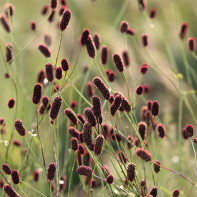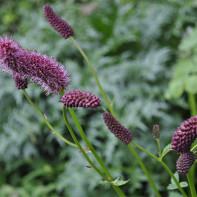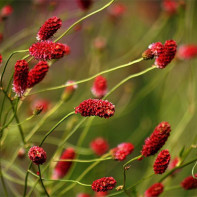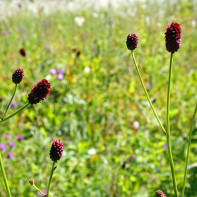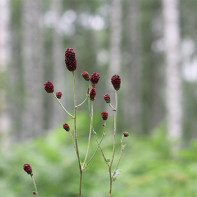Bleb: medicinal properties and contraindications
In the summer months in the fields and forest glades you can find a herb with dark red fluffy cones, which is a good addition to any bouquet. This is bloodroot, a medicinal plant known for its medicinal properties. Modern medicine uses thick rhizomes and sprouts from them. Healers of different nations take all parts of this perennial for preparing potions.
- Chemical Composition
- What it looks like and where it grows
- Types of
- Collection and Storage
- Curative properties of burnet
- For Women
- For Men
- In Pregnancy
- For children
- Borage in traditional medicine
- Irrigation infusion for erosion and fibroids
- Decoction for inflammation of the eyes
- For stopping bleeding in women
- Hemorrhoids remedy (decoction)
- Worm Remedy
- Pain reliever
- Rubbing
- Fresh leaf for heartburn
- Sanguine liniment for burns
- Herbal compress
- Infusion of dried leaves and stems
- Ointment (Korean traditional medicine recipe)
- Types of medicinal compositions
- Infusion
- Infusion
- Decoction
- Tea
- Contraindications to use
- Interesting Facts
Chemical composition
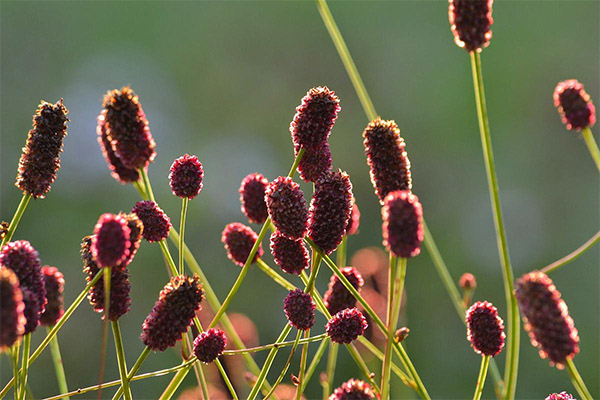
The rhizomes of the plant are rich in useful substances. They contain about 23% of tannins, which have astringent and coagulant properties. The root pulp contains 30% starch, a lot of essential oil, there are natural dyes, organic acids (ellagic, ascorbic, gallic acid), natural pigments-colorants. The plant contains saponins - organic glycosides that do not contain nitrogen and have surface-active qualities, sterols. Blood thistle contains dozens of useful trace elements and macronutrients that are assimilated by the human body (mg/g):
- aluminum (0.31);
- barium (5.70);;
- boron (2.01);
- vanadium (0.12);
- iron (0.40);;
- iodine (0.10);
- calcium (23.20);
- cobalt (0.04);
- potassium (5.80);
- magnesium (2.90);
- manganese (0.47);
- copper (0.59);
- nickel (1.15);
- lead (0.06);
- selenium (1.39);
- strontium (6.14);
- chromium (0.03);
- zinc (1.02).
The ability to accumulate selenium, strontium, nickel and barium in high concentrations makes medicinal sanguine a unique plant among other herbaceous species.
What it looks like and where it grows
It is also called glandular or apothecary. In Latin, the plant is called Sanguisorba officinalis, reflecting its medicinal properties. Sanguis translates as "blood", sorbere as "absorption", "sorbing", "hobbling".
The genus Sanguine belongs to the Rosaceae family. In Russian, the herb has different names, many of which appeared hundreds and thousands of years ago. In Russian regions the plant is referred to as cinquefoil, jalowy zolotnik, mahogany, rowanberry, burnet, sanguine, sabina and two dozen other words.
Hemlock has a horizontal, thick, woody rhizome about 12 cm long. From it, lobed, thin lateral spines emerge. They are several centimeters long. Upwards from the rhizome comes a scion covered with a woody bark. A stem grows from it.
The stem is usually single, erect, herbaceous, naked, with vertical "ribs". The inner part of the stem is hollow and tubular. In the middle and upper part, it branches into several additional stalks. Medicinal burnet grows to a height of 35-100 cm.
Long leaves (7 to 25 pieces) grow in the area of the root calyx. They are bright green in spring, but during the summer they wither and turn brown. In the middle and upper part of the stem, the bloodroot throws out elongated, oblong, rounded (egg-shaped) leaves, 7 to 11 on a single petiole. They have a dense dark green coloring on the upper side and a dull bluish coloring on the lower side. The serrated edges of the leaves resemble a saw blade.
Medicinal bloodroot begins blooming in mid-summer and ends in August. The timing and duration depend on the region of growth: in the highlands, flowering begins later and ends earlier than in the plains. The flowers of the plant are peculiar, they do not resemble a rose in any way, although Sanguisorba belongs to the corresponding family. They are dark red, dark purple cones located at the ends of long flower stems. The peduncles are often elongated; some species develop spike-like inflorescences.
The cones consist of many small flowers, 1 to 3 cm long. Flowers consist of four sepals and the same number of stamens, while the corolla petals are absent. The ovary is formed in the lower part of the pistil.
The fruits of the plant are rounded brown nuts 2.5-3.5 mm long. They fully mature in late August to early September.
Where does it grow?
The range of Sanguine is extensive. The plant is widely distributed throughout Europe, in the temperate belt of Asia, in the forest and forest-steppe regions of North America. To grow comfortably, the sanguine needs forest clearings and edges, brushwood, drylands and flooded meadows. The plant feels well on the wet banks of rivers, springs and swamps. But it does not survive in desert regions.
Blood thistle can be found in almost all regions of European Russia. The plant can be seen in the temperate belt of Siberia and Primorye, in forests and on the grassy slopes of the Caucasus mountains.
Species
In nature there are 12 species of Sanguisorba. The structure of their root system and terrestrial part is approximately the same. But the appearance and size of the leaves, as well as the type, shape, length and color of the inflorescences vary greatly. The most common species of wild bloodwort are as follows:
- glandular;
- alpine:
- Sithin's;
- Canadian;
- small-flowered;
- thin-leaved;
- hakusan;
- splendid;
- blunt.
Glandular bloodroot is widespread in the Far East regions. It is distinguished by its reddish, "rusty" pubescence, but otherwise it is completely identical to the medicinal one.
Hakusan is common in the Japanese archipelago, in mountainous areas and along riverbanks. The bush grows up to 80 cm, gives very lush, beautiful inflorescences. At the height of flowering, the panicles droop under their own weight. The leaves of Hassuan sanguine are broad, and the inflorescences are bright pink, covered with long, erect, fluffy stamens.
Alpine occurs in high-altitude meadows of Mongolia, Central Asia and Siberia (Western and Eastern Sayan Mountains). This species has long, drooping inflorescences which are greenish or yellowish-green in color, sometimes with reddish tips of sepals. The bush grows to a height of 45-80 cm. The leaves of Alpine burnet grow long, at the beginning of flowering their length does not exceed 2.5-3 cm, in a month they lengthen to 7-8 cm.
Sikhtinskaya is found in alpine meadows of the far eastern ranges. This sanguine resembles the alpine, but grows to a height of 1.5 m. The inflorescences of this species are greenish-white and large, up to 12 cm long and up to 2 cm in volume. At the end of flowering, the panicles elongate and droop.
The Canadian burnet grows up to 2 m. It is found in damp glades, damp meadows of the North American continent. It is a beautiful plant with upright, sturdy stems and large white inflorescences.
Bluntbill grows in the mountainous regions of Japan. It grows up to 1 m and blooms in bright pink inflorescences. A variety of blunt halcyon is the Alba variety, which gives long snow-white inflorescences.
Small-flowered is common in Japan, northeast China and the Russian Far East, mainly in the wet river valleys. This species has narrow, long leaves 6-10 cm wide. During the flowering period, the plant is covered with a large number of long white inflorescences. The panicles reach a length of 7 cm or more. The height of the bush averages 100 cm.
Thin-leaved is a hybrid, which appears by cross-pollination of small-flowered and medicinal species. The plant reaches 180 cm in height. During flowering, the bush is covered with lush, oblong pink panicles. It is not always singled out as a separate species, but the hybrid was included in the reference book "Flora of the USSR" under its own name.
The splendid sanguine is a resident of the Russian Far East. This species grows on rocks, root outcrops of limestone. Compared with its water-loving cousins, this straggler is not tall, the shrub rarely grows more than 30-50 cm. The leaves of the plant are greenish, bluish. During abundant flowering, the bush is densely covered with fluffy, shaggy pink panicles.
Collection and storage
Wild sanguine is harvested in regions where the plant is widespread. These include Tatarstan, the southern and middle Urals, and some parts of Siberia. As raw materials are rhizomes and their offshoots.
For harvesting choose healthy, strong shrubs five years or older. Some herbalists recommend digging up roots at the height of flowering, when the inflorescences become dark red, while others recommend digging roots at the end of the flowering period, when the seeds begin to ripen.
In the wild, do not dig up all the roots in a row, leaving 1-2 plants per 10 m² for the species to regenerate. Do not extract rhizomes from the same spot every year. Biologists recommend making a repeated extraction on a particular site once every 10 years, otherwise the population will not recover, and the rhizomes of new plants will be thin.
Roots are dug with a bayonet shovel with a sharp rounded blade. Digging up at a distance of 15-20 cm from the stem, deepening the tool to the length of the bayonet. If you dig closer, you can cut the lateral roots and damage the central one, because the root system of the plant is horizontal.
From the loosened soil, the root part is selected by hand. Then cut the stem and carefully shake off the lumps of soil. Roots are washed in clean cold water, then cut into pieces 15-20 cm long and laid out to dry. Slices quickly oxidize and darken in contact with air, so prepare large enough pieces for drying. First, the raw material is aired (dried) under a shelter, in a well-blown place. On the roots should not get rain water.
Then placed in a permanent place for drying. High temperatures do not destroy the useful substances that make up the blood-roller. Therefore, the raw material can be dried in an oven (temperature 40-50 degrees), in a fruit dryer and under sunlight. Do not dry on a rack over an open fire, on an iron sheet, tray. If the roots blacken, charred, then sanguine will lose its medicinal properties.
Roots are considered dried if they do not bend, but break. The raw material is odorless and has a specific astringent taste. The finished product is stored in canvas bags, paper bags or boxes, at normal (room temperature), without access to direct sunlight. Shelf life of raw materials is 5 years.
Curative properties of burnet
The medicinal properties of hotsfoot provide dozens of beneficial substances included in the composition of the roots. The ground greens also have medicinal properties.
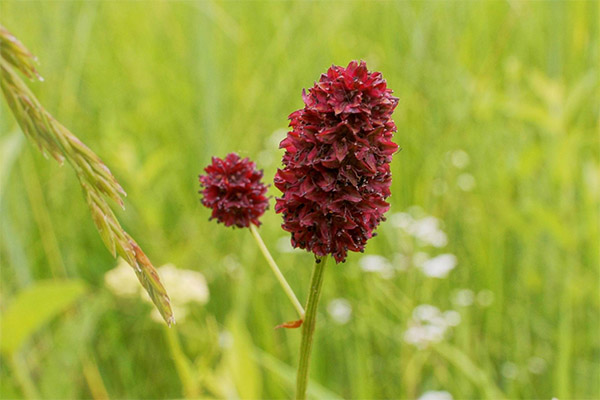
- Tannins present in the roots of the plant have a styptic and astringent effect. They react with proteins, causing them to clot. Therefore, a protective, waterproof film is formed on the surface of wounds, mucous membranes, that is, tanning occurs, and vessels are narrowed.
- The effective antiseptic action of the plant is due to the complex work of substances. Bloodwort has a detrimental effect on a number of microorganisms.
- The substances in the roots have an anti-inflammatory and analgesic effect on the body. The remedy effectively affects the intestinal mucosa, blocks spasms, slows down peristalsis and eliminates pain.
- Due to the large number of micro- and macronutrients, the presence of useful organic acids, plant raw materials are used as a general tonic, health-improving and tonic preparation.
- Organic acids actively break down fats and help maintain an optimal hydrosaline balance.
- Ascorbic acid (vitamin C) - an active antioxidant that is involved in many biochemical processes of the body, the synthesis of hormones, tissue regeneration. This substance strengthens capillaries and is involved in the synthesis of collagen, cholesterol metabolism. Ascorbic acid is an anti-allergic and anti-inflammatory substance that activates the production of collagen and improves liver function.
- Starch is found in the rhizomes in large quantities. This substance has an enveloping effect on tissues and mucous membranes. Starch is a stimulant for insulin production and also reduces "bad" cholesterol.
- Sterols (steroid derivatives) reduce allergic reactions and control appetite. These substances are responsible for normal heart function.
- Carotenes are involved in metabolic processes, normalizing some chemical reactions. These substances stimulate the restoration of bone tissue.
- The essential oil of burnet soothes the nervous system and improves the metabolism.
- Micro- and macro-nutrients are involved in all body systems and metabolic processes. These substances are important for the proper functioning of internal organs.
Official medicine recognizes the therapeutic properties of the roots of burnet. Doctors prescribe patients decoctions, infusions, extracts and other preparations.
The astringent qualities allow the successful use of sanguineous hyssop for intestinal bleeding arising from poisoning and some infectious diseases, hemorrhoids. Together with medications, blood hocus pocus is indicated for pulmonary bleeding when the exacerbation period is over.
Bloodwort destroys dysentery ameba, salmonella, bacteria of the typhoparatyphoid group, E. coli. It is active against bacteria causing gingivitis and stomatitis, suitable for treating trophic ulcers.
Remedies from the roots of the plant inhibit the gag reflex, have an anticonvulsant effect. They are recommended for use internally and externally in the treatment of burns, wash wounds. Solutions and infusions are recommended for the treatment of inflammatory eye diseases (blepharitis, conjunctivitis). Blood lily has a fortifying effect, it is recommended in the treatment of diarrhea.
The plant has a therapeutic effect in digestive disorders caused by various reasons, including eating disorders, indigestion, gastritis. Bloodwort is prescribed internally for colitis, bladder inflammation, giardiasis, inflammatory kidney disease.
For women
Bromegrass has shown itself well as an additional remedy for the treatment of gynecological diseases. The astringent and bactericidal properties of the plant allow you to use self-cooked preparations for uterine, heavy menstrual bleeding, as well as for pain in the "critical days". They are taken internally, in the form of infusions or decoctions. The preparations constrict blood vessels and contract the uterus.
Sanguine-based remedies are used for cervical erosion and uterine fibroids. For treatment, sprinkling is done. Decoctions and infusions are also taken internally to prevent myoma.
Bloodwort treats bacterial vaginosis. This is a non-inflammatory disease in which the composition of the microflora changes. To treat it, sprinkling is used. In the same way it is used in the treatment of trichomonas colpitis (along with medication).
For men
In the list of men's illnesses there are many ailments that are accompanied by inflammation. In this case, the doctor may recommend taking medications from bloodwort. This is, for example, acute and chronic prostatitis. In the case of "universal" diseases, men and women use sanguine in the same way.
In pregnancy
Pregnant women should not be treated with sanguine. Infusions and decoctions act as antispasmodics, which can complicate the course of pregnancy. Nursing mothers should also remove sanguine from their medicine cabinet. Tannins, esters can change the taste of milk and worsen its quality, causing the baby to reject the breast.
For babies
Bloodwort can be treated even for infants under one year of age. But before using an herbal remedy, you should consult a pediatrician.
- Hibiscus can be given to children for intestinal infections (dysentery, infestation with bacteria of the typhoparatyphoid group).
- Decoctions of burnet are prescribed for the treatment of diarrhea (toxic, gastrointestinal) and enteritis.
- Plant therapeutic solutions are indicated for gingivitis, stomatitis, they wash the mouth cavity and gums. For the gums, a strong concentration infusion is better suited.
- The doctor can prescribe sanguine if the child has cramps, intestinal colic.
- Decoction of the root is recommended to treat scratches, burns, ulcers, poorly healing wounds.
In the past, the fragrance of blooming burnet was considered medicinal. In the 17th century, it was recommended to be inhaled by children with neurological diseases right in the field.
Sanguine in folk medicine
Folk medicine treats a multitude of ailments with sanguine. Healers keep and pass down from generation to generation recipes for decoctions, infusions, ointments, powders and other preparations made from this plant.
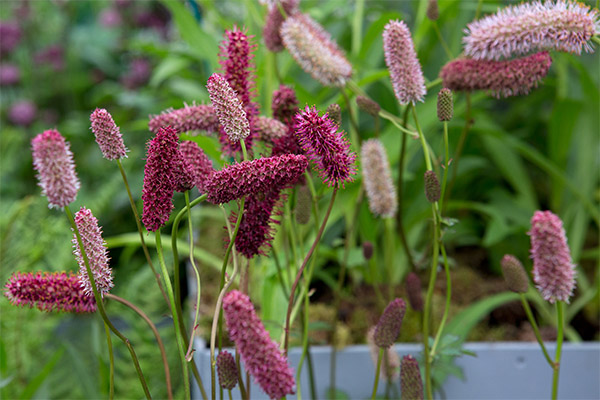
Irrigation infusion for erosions and fibroids
Half a cup of dried roots pour boiling water (700-800 ml). The vessel is closed and the remedy insists for at least 4 hours. After that, the solution is carefully filtered through a cloth and conduct sprinkling. The frequency of the procedure is coordinated with the doctor.
Decoction for inflammation of the eyes
Inflamed eyelids and cornea are treated with a chilled decoction. A tablespoon of chopped rhizomes pour a glass of water, boil for a quarter of an hour over low heat. Then cover with a lid, cool and strain through several layers of cloth. In the solution should not float particles of the root, which can injure the eyes during procedures. If necessary, strain repeated several times. The eyes are rinsed several times a day, using a piece of absorbent cotton or a cotton disk. In this recipe, sage can be brewed along with bloodwort.
To stop bleeding in women
Fill half a liter jar with finely chopped dried rhizomes. Pour the vessel to the top with vodka (but it is better to take medical alcohol 70% strength). The remedy is insisted in a cool, dark place for at least 2 months (but you can withstand three). The treatment is carried out as follows: 5 times a day drink 30-40 drops of tincture (after a meal).
Hemorrhoids remedy (decoction).
In a mug boil a glass of water and pour into it a spoonful of chopped roots of burnet. The ingredients are stirred and let the broth boil for another half an hour. Cover and stew for 3 hours, then strain through a cloth or several layers of gauze. Decoction in any amount poured into a warm sitting bath, as well as taken internally (on an empty stomach, a tablespoon per day).
Remedy for worms
This ancient remedy is effective for the expulsion of worms. In a half-liter mug of hot water, put a shot of crushed rhizomes (without the top). The remedy is put on low heat and boiled for a quarter of an hour. Then cool and strain. The solution is drunk in the morning, in four doses (before meals). History has preserved information that in the 16th century, this herb was used to rid horses of worms.
Pain relieving lotion
To prepare a lotion, you will need a cup of fresh, finely chopped leaves of burnet. In winter, you can replace them with dried leafy raw materials (you will need a few teaspoons). The prepared herb is poured on gauze and tied with a knot. The gauze is immersed for one minute in just boiling water, then placed in a clean plate and cooled to a comfortable temperature. The lotion is placed on the sore joint or muscle, then covered with a towel. The compress is held for up to an hour or more.
The same lotion has a regenerating effect after sunburns.
Rubbing
This home remedy is good for reducing joint and muscle pain, as well as a temporary remedy for toothache. The solution is prepared with vodka or alcohol with a strength of 40 degrees. Take the dry raw material of burnet, Xanthium, Cupain, cinquefoil (one spoon) and grind it. Add two equal measures of lilac flowers and oak bark. Herbs poured into a jar and pour a glass of vodka, close tightly. Infusion insist in a room without sunlight for two weeks, then put in the refrigerator and apply as needed. Insist sanguine long - 2-3 months.
Fresh leaf from heartburn
Folk healers recommend sanguine as a remedy to reduce heartburn. Fresh leaves are plucked from the plant and chewed, then swallowed. A few leaves can help you get rid of a burning sensation in the esophagus.
Sanguine liniment for burns
For preparation you need crushed roots and 80 ml of alcohol (or ready-made alcoholic extract of burnet from a pharmacy), 45-50 ml of liquid oil (olive, Vaseline or sunflower). The ingredients are mixed in a clean bowl until completely dissolved, in the resulting emulsion add a couple of drops of camphor and 10 grams of berberine. The liniment can be smeared on burns, if there is no damage to the skin.
Herbal compress
Compress can be made by taking fresh or dried leaves, stems, flowers. Raw materials are finely chopped and steeped in boiling water. Then let cool and put on gauze in an even layer. Cover the top with a cloth or another piece of gauze. A compress is applied to wounds, sores, scratches, it can be used for burns of 1 degree.
Infusion of dried leaves and stems
It is recommended to use if there are no rhizomes of the plant available. A shot of dry grass is poured into a half-liter container and pour cool, pre-boiled water. The remedy is infused for 8 to 10 hours. The infusion is used as an anti-inflammatory drug, it is drunk up to four times a day (before each meal).
Ointment (Korean traditional medicine recipe)
The remedy is designed to treat eczema. The rhizomes are heated until the initial signs of charring and ground in a mortar to a powder. Then measure 3 portions of the powder and 7 portions of petroleum jelly and mix thoroughly. The resulting mass is applied to the affected skin in the morning and evening for a week. During this time, should manifest healing effect.
Types of medicinal compositions
Decoctions, teas and infusions for the treatment of various diseases differ in the concentration of raw materials, amount of water, duration of heat treatment and infusion. The concentration determines the frequency of application and the effectiveness of the remedy. It is best to prepare homemade preparations in strict accordance with the recipe given on the pharmacy package of burnet.
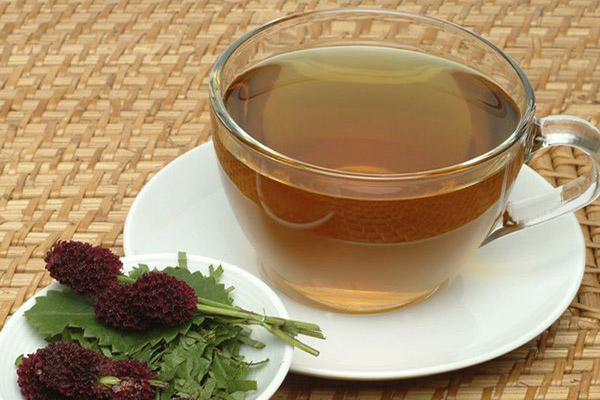
There are general rules of preparation of infusions, teas and decoctions, which are the same for all kinds of herbal raw materials. Official medicine recommends to follow the recommendations of reliable suppliers of plants.
Infusion .
Infusions are prepared by pouring dried raw materials (less often - fresh) with hot water and soaking for several hours. There are two ways of preparing such medicines.
In the first case, just pour the raw material and insist, in the other - pour hot water (preferably using metal enamelware) and put in a "water bath. Water in the bath is heated to boiling and boiled for as long as specified by the manufacturer of herbal raw materials. Then remove the pot with the infusion and cool.
Rhizomes burnet in a water bath is not necessary. Raw measure with a spoon, pour into a vessel, pour boiling water and just soak for a certain time (not less than a quarter of an hour). Prepare infusions in the same way, if the bloodwort is packaged in sachets.
If the solution is thick (for example, to wash the eyes or burned skin), add boiling water.
Tincture
To prepare a tincture, you need medical alcohol or regular vodka. You can use any of these ingredients. The technology of preparation of the remedy is not complicated. Dry raw materials (rhizomes) are measured with a spoon and poured into a glass jar. The concentration depends on the recipe of the author. Then pour the alcoholic beverage and close with an airtight lid.
The tincture does not like sunlight, so it should be put away, on a darkened shelf or in a corner, best of all - in a cool place. After that, the jar is removed to the refrigerator. Frequency of use of the remedy, as well as the dosage, it is better to agree with your doctor.
Decoction .
Medical sources do not recommend preparing decoctions by boiling raw materials in a pot. They are prepared in the same way as infusions. The herb is poured into an enamel pan, pour hot water and put in a water bath.
What is the difference between prepared remedy and infusion? The answer is simple: the soaking time in a water bath. In some cases, it is an hour or more. As a result, the extraction (extraction, extraction) of useful substances goes more intensively, and the remedy is more concentrated.
This should be considered when preparing infusions of complex herbal gatherings. Do not enter in the decoction herbs that are not recommended to be prolonged heat treatment (as the rhizomes of burnet).
Tea .
To make tea, herbal raw materials are poured over boiling water and allowed to stand for a few minutes. The hot beverage is immediately ready to drink. As a brew use herbs, leaves, crushed roots, berries.
When making tea from burnet, use both dried rhizomes and leaves, or a mixture of both. For a large tea mug of 250-300 ml is enough 1-2 teaspoons of plant raw materials. They are poured with boiling water. The tea is ready in five minutes. When treating, you can drink two cups a day.
Contraindications to use
Medicines based on burnet are not prescribed for constipation, high blood pressure, cerebral vascular spasms. They can not be taken with thrombophlebitis and high blood clotting.
Treatment with this herbal remedy is contraindicated if a person has an individual intolerance to the substances that make up the plant. Allergic reactions are manifested by rashes, redness of the skin, nausea, in severe cases - edema.
Interesting facts
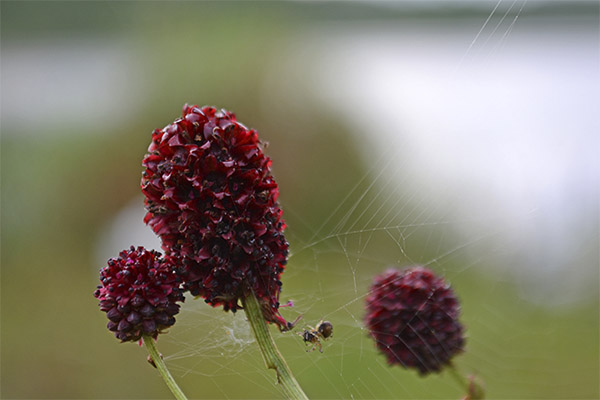
- Hemlock is an amazing herb that contains dozens of useful substances and elements. It not only cures diseases, but also looks beautiful and is actively used by florists. The graceful, beautiful plant is included in exquisite bouquets and floral arrangements.
- Popular breeding varieties of Sanguine are Chocolate Tip, Red Zander, Pink Brushes, Mensissa, Resus, Tanna, and Pink Tanna. Interestingly, the wild representatives of this genus live up to 40 years, the breeding garden ones up to 8 years. All species of wild sanguine are resistant to fungal attack, viral diseases. They are winter-hardy perennials that grow well in the penumbra and in open areas.
- Blood lily relates to edible herbs. Almost all parts of the plant are edible. The rhizomes, which are rich in starch, can be boiled in water or milk. The leaves are good for salad. The greens have a pleasant cucumber flavor and a peculiar nutty aroma. Especially tasty juicy spring leaves. They are quite soft and not prickly. The leaves can also be added to okroshka and hot soups, but only as a fresh condiment. Heating degrades the flavor of the herbs and destroys the aroma.
- You can add not only ginger to homemade lemonades, but also bloodwort leaves. They will give the drink a new flavor note. In lemonades, the greens of huckleberries go well with mint. In meat dishes it is added together with tarragon, parsley and rosemary.
- Not only the leaves, but also the flowers of this plant found use in Eastern cuisine. They improve the taste of roasts and first courses.
- Horsemeat greens are added to cheeses, this plant diversifies sauces and meat gravies. From the green leaves even make the original vinegar, which has a special fresh flavor.
«Important: All information on this site is provided for informational purposes only for information purposes only. Consult a health care professional before using any of our recommendations. specialist. Neither the editors nor the authors are liable for any possible harm caused by materials."

